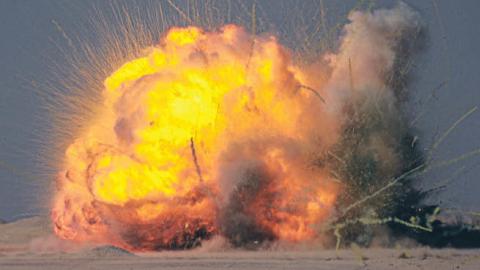Vladimir Putin’s invasion of Ukraine has been a wake-up call. Footage of missile strikes and burned-out tanks reminds us that control of territory still matters, and that the explosive power behind munitions like missiles, rockets, and artillery is key to asserting control of the battlefield.
What these munitions have in common is that they rely on energetic materials — critical chemicals that help determine the range, size, and explosive power of missiles and rockets. Unfortunately, since the end of the Cold War, the United States has underinvested in energetics and now faces serious supply chain vulnerabilities. If the United States is pulled into a protracted war, it could find itself outgunned, fast.
Energetics come in three main forms: explosives; propellants, which produce thrust; and pyrotechnics (think flares or fireworks). This means that better energetics offer major advantages in combat. In some cases, depending on the system, they can boost the range of missiles by 40 percent or more — allowing the targeting of an adversary from a safer distance — while also improving lethality, upping the likelihood a target is destroyed on the first try. Improved energetics can help the Department of Defense build smaller munitions that still pack a punch. At the operational level, defending allies and partners such as Japan, South Korea, the Philippines, and Taiwan from Chinese aggression will require an ample supply of munitions powered by energetic materials.
Yet the supply chain for a broad range of energetics has badly eroded, which could limit US access to munitions during a crisis.
According to a 2018 DoD study, China is “the sole source or a primary supplier for a number of critical energetic materials used in munitions and missiles.” The munitions supply chain also features an alarmingly high number of single points of failure: of 198 second- and third-tier suppliers in the industrial base, 98 percent rely on a single or sole source. And the materials that are produced in the United States tend to be made in in a handful of outdated, government-owned facilities using 20th century equipment.
Even worse, the United States has fallen behind our adversaries in deploying advanced energetics. Both Russia and China employ CL-20, the most powerful non-nuclear explosive in the world. American scientists invented CL-20 in the 1980’s, but bureaucratic hurdles, coupled with complacency as the Cold War ended, meant that DoD never deployed it at scale. Instead, the US military still relies on many of the same materials it used during World War II.
Meanwhile, China may be positioning itself to lead the world in the energetics of the future. Data from Georgetown’s Center for Strategic and Emerging Technologies suggests that over the past five years Chinese scientists have published nearly seven times as many papers relating to energetics materials than have their American counterparts. And the Energetics Technology Center has pointed out that China “heavily supports four top academic institutions to perform energetics research and develop their workforce.”
The US lags behind advanced energetics research. “I was away from the energetics field for 31 years,” noted a former DoD scientist we spoke with. “While I was gone, nothing changed.”
To make up for years of underinvestment, Congress and the White House must partner with the Defense Department to bring the US energetics enterprise into the 21st century. This effort must start with a shift in mindset — our national security leaders must recognize that energetics, and munitions more broadly, cannot be taken for granted. DoD should provide a clear demand signal for new compounds and require its weapons programs to incentivize greater range, speed, and lethality.
Second, the White House and Congress must work with the Department of Defense to rebuild energetics production in the United States and allied nations. The US needs a resilient supply chain that does not depend on a handful of outdated facilities and the good graces of our adversaries. The Defense Production Act could be used to provide loans, grants, and purchase agreements to startups and defense companies willing to invest in these critical compounds. And defense leaders can use the AUKUS pact to boost production capacity and create munitions stockpiles, building on Australia’s announcement that it will invest $1 billion to build a Sovereign Guided Weapons Enterprise.
Third, Congress and Department leadership should boost R&D funding for energetics to encourage the development of new compounds, using artificial intelligence and machine learning to drive new breakthroughs.
The Covid-19 pandemic revealed that global, just-in-time supply chains come with serious security risks. But vulnerabilities in energetics production reveal that, like so many of these problems, wounds are often self-inflicted. Dealing with a dangerous world means preparing to deter and if necessary, fight and win wars.
Investing in the resources we need, like munitions and the energetics that power them—is a crucial first step. Production at scale still matters. Absent a robust industrial base for munitions and energetics, America’s ability to fight and win a protracted war is in jeopardy.
Read in Breaking Defense















